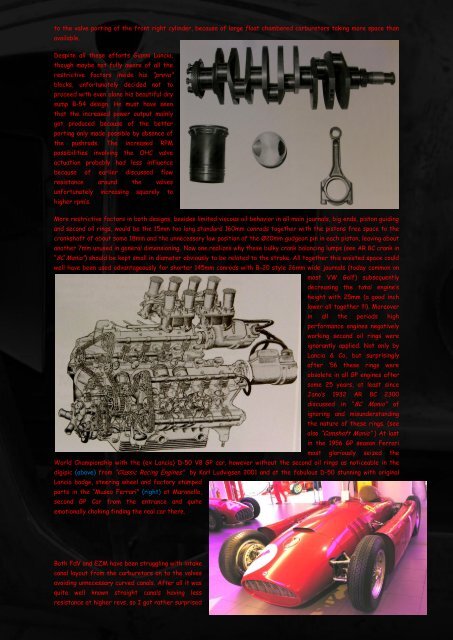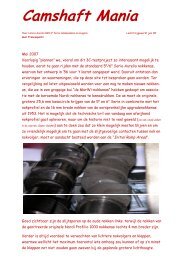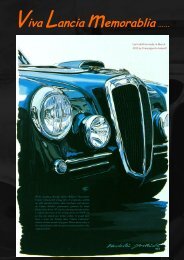You also want an ePaper? Increase the reach of your titles
YUMPU automatically turns print PDFs into web optimized ePapers that Google loves.
to the valve porting of the front right cylinder, because of large float chambered carburetors taking more space than<br />
available.<br />
Despite all these efforts Gianni Lancia,<br />
though maybe not fully aware of all the<br />
restrictive factors inside his “prova”<br />
blocks, unfortunately decided not to<br />
proceed with even alone his beautiful dry<br />
sump B-54 design. He must have seen<br />
that the increased power output mainly<br />
got produced because of the better<br />
porting only made possible by absence of<br />
the pushrods. The increased RPM<br />
possibilities involving the OHC valve<br />
actuation probably had less influence<br />
because of earlier discussed flow<br />
resistance around the valves<br />
unfortunately increasing squarely to<br />
higher rpm‟s.<br />
More restrictive factors in both designs, besides limited viscous oil behavior in all main journals, big ends, piston guiding<br />
and second oil rings, would be the 15mm too long standard 160mm conrods together with the pistons free space to the<br />
crankshaft of about some 18mm and the unnecessary low position of the Ø20mm gudgeon pin in each piston, leaving about<br />
another 7mm unused in general dimensioning. Now one realizes why these bulky crank balancing lumps (see AR 8C crank in<br />
“8C <strong>Mania</strong>”) should be kept small in diameter obviously to be related to the stroke. All together this waisted space could<br />
well have been used advantageously for shorter 145mm conrods with B-20 style 26mm wide journals (today common on<br />
most VW Golf) subsequently<br />
decreasing the total engine‟s<br />
height with 25mm (a good inch<br />
lower all together !!!). Moreover<br />
in all the periods high<br />
performance engines negatively<br />
working second oil rings were<br />
ignorantly applied. Not only by<br />
Lancia & Co, but surprisingly<br />
after „56 these rings were<br />
obsolete in all GP engines after<br />
some 25 years, at least since<br />
Jano‟s 1932 AR 8C 2300<br />
discussed in “8C <strong>Mania</strong>” of<br />
ignoring and misunderstanding<br />
the nature of these rings. (see<br />
also “Camshaft <strong>Mania</strong>” ) At last<br />
in the 1956 GP season Ferrari<br />
most gloriously seized the<br />
World Championship with the (ex Lancia) D-50 V8 GP car, however without the second oil rings as noticeable in the<br />
digipic (above) from “Classic Racing Engines” by Karl Ludvigsen 2001 and at the fabulous D-50 stunning with original<br />
Lancia badge, steering wheel and factory stamped<br />
parts in the “Museo Ferrari” (right) at Maranello,<br />
second GP Car from the entrance and quite<br />
emotionally choking finding the real car there.<br />
Both FdV and EZM have been struggling with intake<br />
canal layout from the carburetors on to the valves<br />
avoiding unnecessary curved canals. After all it was<br />
quite well known straight canals having less<br />
resistance at higher revs, so I got rather surprised





